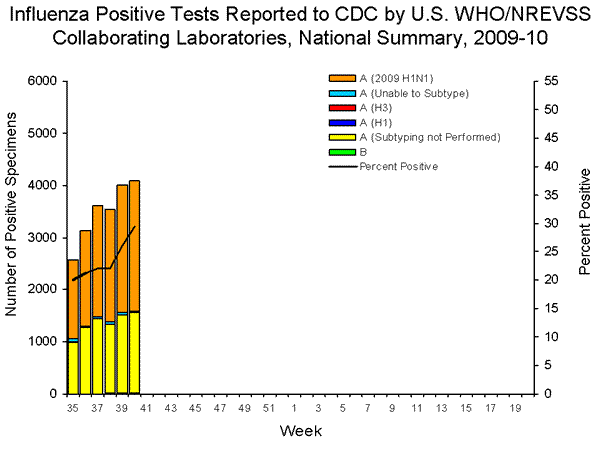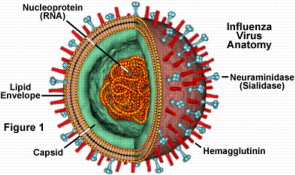Under Construction 
The Centers for Disease Control and Prevention (CDC) estimates that 10 to 20 percent of Americans come down with the flu during each flu season, which typically lasts from November to March. Children are two to three times more likely than adults to get sick with the flu, and children frequently spread the virus to others. Although most people recover from the illness, CDC estimates that in the United States more than 100,000 people are hospitalized and about 36,000 people die from the flu and its complications every year.
Sumptoms:
If you get infected by the flu virus, you will usually feel symptoms 1 to 4 days later. You can spread the flu to others before your symptoms start and for another 3 to 4 days after your symptoms appear. The symptoms start very quickly and may include:
- Body aches
- Chills
- Dry cough
- Fever
- Headache
- Sore throat
- Stuffy nose
Typically, the fever begins to decline on the second or third day of the illness. The flu almost never causes symptoms in the stomach and intestines. The illness that some call "stomach flu" is not influenza.
Influenza Pandemics - Type A flu virus
| Date | Strain | Deaths |
| US | World |
| 1918-19 | H1N1 - Spanish Flu | 500,000 | 21-50 M |
| 1957-58 | H2N2 - Asian Flu | 60,000 | 1 M |
| 1968-69 | H3N2 - Hong Kong | 40,000 | 750 K |
| 1997- | H5N1 - Avian influenza (Bird Flu)
(Other Avian flu virus' H9N2, H7N7, H7N2, H7N3) | ? | 1,368 |
| 2009 | H1N1 - Swine Flu (deaths in 1st 3 weeks) | 275 | ? |
K=1,000, M=Million
Note 1: Some sources report up to 4 Million worldwide deaths in 1957-58
H1N1 - Swine flu (Week 40: Oct 4-10):

Source: www.cdc.gov/flu/
There were about 275 deaths in the 6 weeks from Aug. 30 to Oct. 10.
The 2009 H1N1 virus is a new strain of influenza that first appeared in the United States in April 2009. Early on, it was referred to as "swine flu" because it was genetically similar to influenza viruses that normally occur in pigs in North America. Further study, however, revealed that the virus actually included genes from viruses found in birds and humans, as well as pigs.
See:
CDC - Seasonal Influenza (Flu) - Weekly Report:
In the Oct. 10, 2009 Report they say: "The proportion of deaths attributed to pneumonia and influenza (P&I) was above the epidemic threshold."

Oct. 13, 2009
It's still all theory, but UC Davis researchers think that the reason senior citizens over age 65 aren't catching the H1N1 flu at least for now is that specific shared molecular sites called epitopes result in some type of immunity to the novel flu. It seems people over age 65 have been exposed to various type A flu viruses in the past that have stimulated immunity responses in which their T-cells clear out the novel flu viruses.
See: "Earlier Flu Viruses Provided Some Immunity to Current H1N1 Influenza, Study Shows" at news.ucdavis.edu
MIT, CDC find H1N1 flu virus ill-suited for rapid transmission,
but researchers say new strain bears watching, could mutate.
Other Links:
H1N1-influenza as Lazarus: Genomic resurrection from the tomb of an unknown -- PNAS
In 1976, the United States experienced a swine flu scare. When a new flu virus was first identified at Fort Dix, New Jersey, it was labeled the "killer flu," and health experts were afraid that it would infect people around the world. In fact, swine flu never left the Fort Dix area.
Avian influenza (bird flu):
Several instances of human infections and outbreaks of avian influenza have been reported since 1997. They are thought to be transmitted by direct contact with infected birds or poultry.
In Oct. 2005 birds infected were found in Europe. That plus new research indicating the strain causing the 1918 pandemic was related to an avian strain of H1N1 is causing renewed fears of a new pandemic. However, it may take years for it to mutate so it can infect humans.
See "MD: Avian flu must mutate for it to sicken humans" at CNN.
Virologists think that many flu virus' start with wild birds and are transmitted to domestic birds (chickens, ducks, ..) then mutate to infect pigs and finally humans.
Types of Flu Viruses:
The influenza virus is a class of viruses containing RNA as its hereditary material. It replicates by entering a host cell and using this cell's resources to produce hundreds of copies of the viral RNA.
There are three types:
Type A is the most common, causing all the major pandemics above.
Type B outbreaks also can cause epidemics, but the disease it produces generally is milder than that caused by type A.
Type C is generally less prevalent and does not develop fully enough to produce flu symptoms. Type C viruses have usually been associated with symptoms suggesting a common cold.
Type A viruses also infect domestic animals (pigs, horses, chickens, ducks) and some wild birds.
Not until 1930 (in pigs) and 1933 (in humans) was it established that influenza is caused by a virus.
 The influenza A virion is a globular particle (about 100 nm in diameter) containing 8 pieces of RNA sheathed in a lipid bilayer membrane. Studded in the lipid bilayer are two integral membrane proteins, hemagglutinin [HA] and neuraminidase [NA]. Type A viruses are identified by their HA and NA proteins e.g. H1N1. The 8 pieces of RNA are:
The influenza A virion is a globular particle (about 100 nm in diameter) containing 8 pieces of RNA sheathed in a lipid bilayer membrane. Studded in the lipid bilayer are two integral membrane proteins, hemagglutinin [HA] and neuraminidase [NA]. Type A viruses are identified by their HA and NA proteins e.g. H1N1. The 8 pieces of RNA are:
1. The HA gene. It encodes the hemagglutinin. 3 distinct hemagglutinins, H1, H2, and H3) are found in human infections. Nine others have been found in animal flu viruses.
2. The NA gene. It encodes the neuraminidase. 2 different neuraminidases (N1 and N2) have been found in human viruses; 7 others in other animals.
3. The NP gene encodes the nucleoprotein. Influenza A, B, and C viruses have different nucleoproteins.
4. The M gene encodes the two matrix proteins (using different reading frames of the RNA).
5. The NS gene encodes two different non-structural proteins (also by using different reading frames).
6 - 8. One RNA molecule (PA, PB1, PB2) for each of the 3 RNA polymerases.
See Structure at Influenza on Kimball's Biology Pages.
There are many different subtypes of type A flu viruses. These subtypes differ because of the types of hemagglutinin [HA] and neuraminidase [NA] proteins on the surface.
CDC researchers and their colleagues successfully reconstructed the influenza virus that caused the 1918-19 flu pandemic and reported their findings in "Characterization of the Reconstructed 1918 Spanish Influenza Pandemic Virus," which was published in the October 7, 2005 issue of Science.
They found the 1918 virus gene sequences are related more closely to avian H1N1 viruses than are any of the other known mammalian influenza H1N1 strains. The results of this research will be taken into account as part of the ongoing pandemic preparedness planning process.
It was called the Spanish flu because because Spain, a neutral country in WWI, had no special censorship for news against the disease and its consequences., but the UK, US and France had the first cases.
Vaccines:
Scientists make a different vaccine every year because the strains of flu viruses change from year to year. Nine to 10 months before the flu season begins, they prepare a new vaccine made from inactivated (killed) flu viruses. Because the viruses are killed, they cannot cause infection. The vaccine preparation is based on the strains of the flu viruses that are in circulation at the time. It includes those A and B viruses (see section below on types of flu viruses) expected to circulate the following winter.
At the Flu Fact Sheet the CDC recommends getting vacinated
if you are in any of the following groups or live in a household with someone who is.
- You are 50 years of age or older
- You have chronic diseases of your heart, lungs, or kidneys
- You have diabetes
- Your immune system does not function properly
- You have a severe form of anemia
- You will be more than 3 months pregnant during the flu season
- You live in a nursing home or other chronic-care housing facility
- You are in close contact with children 0 to 23 months of age
How is it spread?
Influenza and other respiratory viruses can be transmitted in one of two ways: by inhaling infectious particles in the air (like respiratory secretions from a cough or sneeze), or by touching respiratory secretions, usually on the skin, of an already-infected person and then touching one's eyes or nose. Shaking hands, for example, with an infected person, or touching environmental surfaces (like doorknobs or handrails) that have been contaminated with flu virus particles (the virus can live for several hours on these surfaces) and then touching your eyes or nose may transmit the virus.
The best prevention other than a flu shot is frequent washing of your hands.
Treatment?
Flu sufferers should drink fluids, try to eat, and get plenty of rest, says Lambert. Your body is trying to attack the virus, and it takes energy to do that.
See:
Flu and Information About Influenza Pandemics at the Centers for Disease Control and Prevention (CDC)
The Influenza (Flu) Virus at fsu.edu
Fighting the Flu at the FDA
Pandemic Influenza at the Infectious Disease Center (ID Center) of the Association for Professionals in Infection Control and Epidemology.
Flu - NIAID Fact Sheet at the National Institute of Allergy and Infectious Diseases in the National Institutes of Health (NIH).
netdoctor.co.uk/hilaryjones
Return to Health
last updated 18 Oct 2009
|  Health
Health
 Flu
Contact
Flu
Contact
 Health
Health
 Flu
Contact
Flu
Contact
